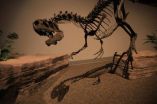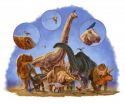(Press-News.org) Theropod dinosaurs, a group which includes such famous species as Tyrannosaurus rex and Velociraptor, are often regarded as carnivorous and predatory animals, using their sharp teeth and claws to capture and dispatch prey. However, a detailed look at the claws on their forelimbs revealed that the form and shape of theropod claws are highly variable and might also have been used for other tasks.
Inspired by this broad spectrum of claw morphologies, Dr Stephan Lautenschlager from Bristol's School of Earth Sciences studied the differences in claw shape and how these are related to different functions.
His research focussed on the therizinosaurs, an unusual group of theropods which lived between 145 and 66 million years ago. Therizinosaurs were very large animals, up to 7m tall, with claws more than 50cm long on their forelimbs, elongated necks and a coat of primitive, down-like feathers along their bodies. But in spite of their bizarre appearance, therizinosaurs were peaceful herbivores.
Dr Lautenschlager said: "Theropod dinosaurs were all bipedal, which means their forelimbs were no longer involved in walking as in other dinosaurs. This allowed them to develop a whole new suite of claw shapes adapted to different functions."
In order to fully understand how these different claws on the forelimbs were used, detailed computer models were created to simulate a variety of possible functions for different species and claw morphologies.
The dinosaur claws were also compared to the claws of mammals, still alive today, whose function (that is, how and for what the claws are used) is already known.
In the course of evolution, several theropod groups, including therizinosaurs, changed from being carnivores to become plant-eaters. This new study reveals that, during this transition, theropod dinosaurs developed a large variety of claw shapes adapted to specific functions, such as digging, grasping or piercing.
Dr Lautenschlager said: "It's fascinating to see that, with the shift from a carnivorous to a plant-based diet, we find a large variety of claw shapes adapted to different functions. This suggests that dietary adaptations were an important driver during the evolution of theropod dinosaurs and their transition to modern birds."
INFORMATION:
The research is published today in Proceedings of the Royal Society B.
Paper
'Morphological and functional diversity in therizinosaur claws and the implications for theropod claw evolution' by Stephan Lautenschlager in Proceedings of the Royal Society B
All teeth and claws? New study sheds light on dinosaur claw function
2014-05-07
ELSE PRESS RELEASES FROM THIS DATE:
Revealing the healing of Dino-sores
2014-05-07
Scientists have used state-of-the-art imaging techniques to examine the cracks, fractures and breaks in the bones of a 150 million-year-old predatory dinosaur.
The University of Manchester researchers say their groundbreaking work – using synchrotron-imaging techniques – sheds new light, literally, on the healing process that took place when these magnificent animals were still alive.
The research, published in the Royal Society journal Interface, took advantage of the fact that dinosaur bones occasionally preserve evidence of trauma, sickness and the subsequent signs ...
Study finds pregnant women show increased activity in right side of brain
2014-05-07
Pregnant women show increased activity in the area of the brain related to emotional skills as they prepare to bond with their babies, according to a new study by scientists at Royal Holloway, University of London.
The research, which will be presented at the British Psychological Society's annual conference on Wednesday 7 May, found that pregnant women use the right side of their brain more than new mothers do when they look at faces with emotive expressions.
"Our findings give us a significant insight into the 'baby brain' phenomenon that makes a woman more sensitive ...
Mass vaccination campaigns reduce the substantial burden of yellow fever in Africa
2014-05-07
Yellow fever, an acute viral disease, is estimated to have been responsible for 78,000 deaths in Africa in 2013 according to new research published in PLOS Medicine this week. The research by Neil Ferguson from Imperial College London, UK and colleagues from Imperial College, WHO and other institutions also estimates that recent mass vaccination campaigns against yellow fever have led to a 27% decrease in the burden of yellow fever across Africa in 2013.
Yellow fever is a serious viral disease that affects people living in and visiting tropical regions of Africa and ...
Water from improved sources is not consistently safe
2014-05-07
Although water from improved sources (such as piped water and bore holes) is less likely to contain fecal contamination than water from unimproved sources, improved sources in low- and middle-income countries are not consistently safe, according to a study by US and UK researchers, published in this week's PLOS Medicine.
These findings are important as WHO and UNICEF track progress towards the Millennium Development Goals water target using the indicator "use of an improved source": this study shows that assuming that "improved" water sources are safe greatly overestimates ...
Dinosaurs and birds kept evolving by shrinking
2014-05-07
Although most dinosaurs went extinct 65 million years ago, one dinosaur lineage survived and lives on today as a major evolutionary success story – the birds. But to what does this lineage owe its success? A study that has 'weighed' hundreds of dinosaurs now suggests that shrinking their bodies may have helped this group to continue exploiting new ecological niches throughout their evolution, and to become such a diverse and widespread group of animals today.
An international team, led by scientists from Oxford University and the Royal Ontario Museum, estimated the body ...
Shrinking helped dinosaurs and birds to keep evolving
2014-05-07
A study that has 'weighed' hundreds of dinosaurs suggests that shrinking their bodies may have helped the group that became birds to continue exploiting new ecological niches throughout their evolution, and become hugely successful today.
An international team, led by scientists at Oxford University and the Royal Ontario Museum, estimated the body mass of 426 dinosaur species based on the thickness of their leg bones. The team found that dinosaurs showed rapid rates of body size evolution shortly after their origins, around 220 million years ago. However, these soon slowed: ...
Patients with AMD may not need monthly injections
2014-05-07
Orlando, Fla. — Researchers have found that, contrary to prvious clinical trial findings, monthly injections to counteract age-related macular degeneration (AMD) may not be necessary. The research is being presented at the 2014 Annual Meeting of the Association for Research in Vision and Ophthalmology (ARVO) this week in Orlando, Fla.
The investigators used a strategy called "treat and extend" to conduct the study, in which the frequency of office visits and injections were tailored to each patient's individual response to therapy. Following 185 patients over a three-and-a-half-year ...
AGU journal highlights -- May 6, 2014
2014-05-06
The following highlights summarize research papers that have been recently published in Geophysical Research Letters (GRL), Journal of Geophysical Research: Earth Surface (JGR-F), Journal of Geophysical Research: Oceans (JGR-C), and Water Resources Research (WRR).
In this release:
1. Polar hexagon-shaped jet stream could reveal Saturn's rotational period
2. Antarctica's Whillans Ice Plain ice flows are highly variable
3. Climate change, water rights, and agriculture: A case study in Idaho
4. Low impact development boosts groundwater recharge
5. Beaufort Gyre sea ...
Black male incarceration can compromise research studies
2014-05-06
Federal restrictions on including prisoners in medical research have negatively impacted research involving black men, who are disproportionately imprisoned, according to a study by Yale School of Medicine researchers. Because individuals who are already in ongoing studies must be dropped if they are incarcerated, this compromises the ability of researchers to examine racial disparities in health outcomes studies.
Published in the May issue of the journal Health Affairs, the study found that during the past three decades, high rates of incarceration of black men may ...
When newlyweds believe in sharing household chores, follow-through is everything
2014-05-06
URBANA, Ill. – Of all the starry-eyed just-married couples you know, which couples are likely to stay the happiest? A University of Illinois study says chances for bliss are highest when husband and wife both believe in divvying up the household labor equally. But that happiness won't last long if one partner is perceived as not carrying their fair share of the load.
"Newlyweds need to thoughtfully plan how they can make their expectations about sharing chores work out in real life, especially if the new spouses strongly value gender equality in household labor. This ...



